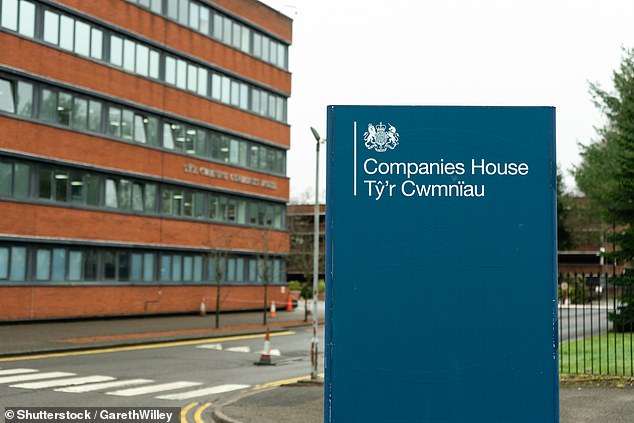We have all daydreamed about landing a windfall — perhaps from a lottery win, Premium Bond prize or a large inheritance from a distant relative.
But one source most of us never consider is finding a long-lost pension pot — even though the odds are thousands or even millions of times more likely.
Savers have lost track of close to three million hard-earned pensions worth a staggering £27 billion in the UK. It equates to just under £9,500, on average, waiting to be claimed.
Pensions are alarmingly easy to lose track of, especially if you have changed jobs, name or moved home and failed to alert all your old pension providers. And once lost, pensions can be difficult to find again.
Today, Money Mail is teaming up with former pensions minister Sir Steve Webb to help readers boost their retirement wealth by locating old pensions.

Lost fortunes: Savers have lost track of close to three million hard-earned pensions worth a staggering £27bn in the UK
We will select five lucky readers who suspect they may have pots they have lost track of – and will use expert techniques to hunt them down.
We invite you to write in with any scraps of information you have regarding your lost pension — even if it is just the name of an old employer or a pension statement from decades ago. And we will do the rest.
Sir Steve says: ‘You might have tried the obvious things and hit a brick wall. We will do our best to find pensions even if all you have is a fragment of information.
As we know the pension industry, it’s possible that we can spot clues hidden in the pension jargon.’
Sir Steve, who is now a partner at consultancy LCP and is one of the most knowledgeable pension experts in the country, has also written an exhaustive guide to finding old pension pots, which he shares today with Money Mail.
You can also do your own detective work to track down long-lost pensions using his five key steps.
What has happened to my missing pension?
It can be hard to keep track of all your pensions. Workers have 12 jobs during their lives on average, many of which will have a different pension.
Your pension is considered dormant if your pension provider sends letters to you that are returned with an explanation that you no longer live at that address and if you do not touch any of your funds for between one and five years.
Once dormant, eventually your money is moved to a central fund, which is put towards good causes through the Big Lottery Fund.
However, it is still possible for you to claim your pension.
1. Get in touch with your old employer
It may be easy to track down an old pension if you have some details about it.
For example, if you know the name of the company your pension was invested with, contact it with your plan number, date of birth, your National Insurance number and the date your pension was set up.
Most people will find they don’t have enough details to go down this route.
Sir Steve says: ‘In a perfect world, the firm you were working for when you built up the pension will still be trading, will still have the same name, and may even have a pensions department or HR manager. But things are rarely that simple.’
In reality, the company you worked for may have merged with others, or been taken over or renamed, making it difficult to know which company to contact now.

Multiple pensions: It can be hard to keep track of all your pensions. Workers have 12 jobs during their lives on average, each one with a different pension
Companies House, a free online database of all UK-registered businesses run by the Government, can be a good place to find out what happened to your old employer and if it is still trading.
Once you know if the company is still in business and what name it operates under, you can then write to it requesting information about past pension schemes. Go to gov.uk/companies-house
If you can’t find information about your employer this way, Sir Steve recommends using the Government’s Pensions Tracing Service, which can be found at gov.uk/find-pension-contact-details.
It’s a free service that can provide contact details for thousands of pension schemes, trustees or administrators. You will need to know the name of the company that you worked for to use it.
However, if the Pension Tracing Service does not have information on your pension, it doesn’t mean it does not exist.
Your employer may have changed name, gone bust or you may have saved into a type of pension that the service does not track.
Sir Steve says: ‘The quality of the information provided is somewhat variable. In some cases, the site will acknowledge that the information held is very old and the contact details may no longer be “live”.’

Pension guru: Sir Steve Webb will help five readers track down missing retirement pots
If your former employer has since closed and no longer exists, the whereabouts of your pot will depend on what kind of pension you had.
Most workers today have modern money purchase pensions called ‘defined contribution’, in which they have built up a personal pot of money.
These pension schemes are managed by a pension provider, not your employer, so your pension should be safe if your employer goes bust. To track it down, you can bypass your former employer and go straight to the pension provider if you know it.
Those with an older ‘defined benefit’ pension, which pays a guaranteed income for life based on the employee’s former salary, should look to a lifeboat scheme called the Pension Protection Fund (PPF) if their former employer has gone bust.
The PPF takes on defined benefit pension schemes for employers that go into liquidation and do not have sufficient funds to honour all their pension commitments.
Over the past two decades, more than 1,000 pension schemes have gone into the PPF, and nearly 300,000 members have their money in the fund.
You can check to see if your pension has fallen into the PPF by using the A to Z list of schemes it covers on its website at ppf.co.uk/schemes.
If your old pension scheme is covered by the lifeboat fund, you should contact the PPF directly.
The fund is also responsible for administering a separate compensation scheme called the Financial Assistance Scheme (FAS), which covers certain insolvencies that took place between 1997 and 2005.
In some complex situations, where an insolvent employer had enough assets to match the PPF’s compensation, your pension may be in the hands of an insurance company.
In this case, contact the insurance company to try to track down any missing pension.
If you cannot remember the name of a former employer, another option is to work it out with information from HM Revenue and Customs.
HMRC will generally have records of who you worked for through its tax database. You can apply for the information via the gov.uk website.

Records: HMRC should also be also to tell you how much you were earning at any point in time
Another way to check that you had an old pension is to look for signs on your National Insurance record that you are one of the millions of workers who saved into what is called a ‘contracted out’ pension scheme.
This is when your employer paid reduced National Insurance contributions on your behalf and put the money into its company pension instead. Employees who were contracted out will receive a smaller state pension, but a larger sum from their workplace one.
HMRC should hold a scheme reference number and scheme name for any period you paid into one of these pensions. That should be enough for you to hand over to a pension provider to claim your pot.
Contracting out started in 1978 and ended in 2016. As a rule of thumb, most salary-related workplace pensions, including public service pensions, operated on a contracted-out basis, Sir Steve says.
Once you are sure you were contracted out, you can write to HMRC for details at: PT Operations, North East England, HMRC, NIC&EO, Benton Park View, Newcastle Upon Tyne, BX9 1AN, or you can call the contracted out pensions helpline on 0300 200 3500.
2. Locate any former colleagues
One simple way to gather information is leaning on people who you used to work with.
Sir Steve says: ‘Even if you don’t have information about the company pension scheme, someone you worked with may do.
If enough time has elapsed, it is likely that a former colleagues is now in receipt of a pension from the very scheme that you are trying to locate.’
If you are no longer in touch with anyone you used to work with, you may be able to track them down on business and social media websites, such as LinkedIn.
3. Find out where your money is held
Pension funds are generally held and managed separately to your employer. The money is usually entrusted by your employer to a specialist pension provider or insurance company.
For example, if your company has a group personal pension, the money is likely to be overseen by a household name insurance company such as Legal & General, Aviva, Standard Life, Royal London and Aegon, which invest savings for you. Your money remains with them even after you have left that employer.
This means you may be able to track down a pension pot even if you have no information about your previous employer or if your previous employer no longer exists, Sir Steve says.
Modern defined contribution pensions can be trickier to keep track of because pension companies can rebrand and change their name (such as Norwich Union becoming Aviva), or sets of policies are bought and sold.
Sir Steve says: ‘This means that if you happen to have old paperwork which bears the name of an old insurance company but cannot track it down, it is possible that your policy has been sold on to another company.’

Companies House, a free database of all UK-registered businesses, can be a good place to find out what happened to your old employer and if it is still trading
A handful of insurers are responsible for millions of ‘legacy’ pension policies because they have bought the right to manage them.
For example, the website of Phoenix Group indicates that ‘brands’ for which it is now responsible include Standard Life, Reassure, Sun Life, Guardian Financial Services, Barclays Life, Alico, National Mutual and Skandia.
Royal London operates pensions which were sold under brands such as Scottish Life, United Assurance, Refuge Assurance, Royal Liver and Co-op Pensions.
If you have an old policy which seems to have been provided by an insurance company which no longer exists, you should be able to search online and find a new provider which has taken on that business, Sir Steve says.
The Association of British Insurers (ABI) has a helpful A-Z list of different insurance companies and the changes of name they have gone through over the years, which can be found at abi.org.uk/data-and-resources/tools- and-resources/find-lost-pension/
4. Track down the administrators
Those who administer pension schemes may also be able to help track pensions, Sir Steve says. The administrator is separate from your employer, pension provider or insurance company and is responsible for the nuts and bolts of running a pension.
This includes keeping records of everyone who has saved into the pension, how much, updating records and paying money in people’s pension accounts.
You should be able to find the name of your pension administrator on old paperwork or letters you have received about your pension. If you haven’t been receiving letters it might be because you changed address and didn’t notify your old pension provider.
Sir Steve says: ‘In principle, those who hold the records for a pension scheme may be best placed to help you track down your pension.’
However, as with pension providers, your pensions administrator can change. If you have any old documents, you may find the name of the administrator on your paperwork or the one shown on the Pension Tracing Service site no longer matches the company which holds the records today.
Some online searching should help you see who a historic firm of administrators was taken over by and then try contacting it about your pension, Sir Steve says.
5. Check out how much you are owed
HMRC should also be able to tell you how much you were earning at any point in time.
Sir Steve says: ‘This could be useful if you could demonstrate to a pension scheme that you were a member, but it has no way of working out how much pension you built up because records for that period were incomplete.’
To get hold of the information, you can make a ‘subject access request’ to HMRC for history of how much you earned in each year. Go to gov.uk/guidance/hmrc- subject-access-request
- Read Sir Steve Webb’s full guide at go.lcp.com/lost-pensions
j.beard@dailymail.co.uk
Some links in this article may be affiliate links. If you click on them we may earn a small commission. That helps us fund This Is Money, and keep it free to use. We do not write articles to promote products. We do not allow any commercial relationship to affect our editorial independence.




